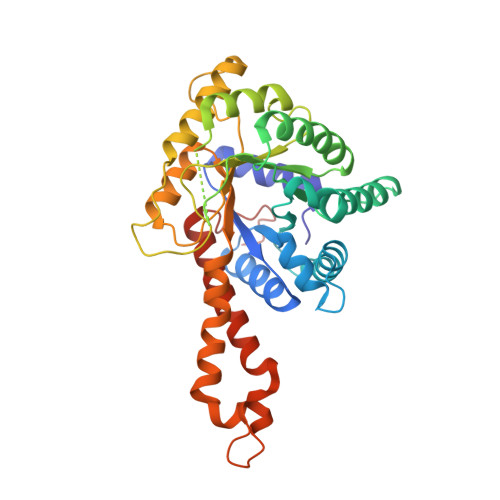Structural basis for catalysis of a tetrameric class IIa fructose 1,6-bisphosphate aldolase from Mycobacterium tuberculosis
Pegan, S.D., Rukseree, K., Franzblau, S.G., Mesecar, A.D.(2009) J Mol Biol 386: 1038-1053
- PubMed: 19167403
- DOI: https://doi.org/10.1016/j.jmb.2009.01.003
- Primary Citation of Related Structures:
3EKL, 3EKZ, 3ELF - PubMed Abstract:
Mycobacterium tuberculosis, the causative agent of tuberculosis (TB), currently infects one-third of the world's population in its latent form. The emergence of multidrug-resistant and extensive drug-resistant strains has highlighted the need for new pharmacological targets within M. tuberculosis. The class IIa fructose 1,6-bisphosphate aldolase (FBA) enzyme from M. tuberculosis (MtFBA) has been proposed as one such target since it is upregulated in latent TB. Since the structure of MtFBA has not been determined and there is little information available on its reaction mechanism, we sought to determine the X-ray structure of MtFBA in complex with its substrates. By lowering the pH of the enzyme in the crystalline state, we were able to determine a series of high-resolution X-ray structures of MtFBA bound to dihydroxyacetone phosphate, glyceraldehyde 3-phosphate, and fructose 1,6-bisphosphate at 1.5, 2.1, and 1.3 A, respectively. Through these structures, it was discovered that MtFBA belongs to a novel tetrameric class of type IIa FBAs. The molecular details at the interface of the tetramer revealed important information for better predictability of the quaternary structures among the FBAs based on their primary sequences. These X-ray structures also provide interesting and new details on the reaction mechanism of class II FBAs. Substrates and products were observed in geometries poised for catalysis; in addition, unexpectedly, the hydroxyl-enolate intermediate of dihydroxyacetone phosphate was also captured and resolved structurally. These concise new details offer a better understanding of the reaction mechanisms for FBAs in general and provide a structural basis for inhibitor design efforts aimed at this class of enzymes.
Organizational Affiliation:
Department of Medicinal Chemistry and Pharmacognosy, University of Illinois at Chicago, Chicago, IL 60607, USA.

















